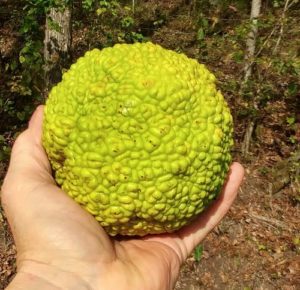by Winding Pathways | Nov 9, 2017 | Nature, Trees/Shrubs
 This fall we’ve noticed Osage Orange fruits for sale in grocery stores and roadside stands. They are fascinating and have a delightful fresh citrus scent.
This fall we’ve noticed Osage Orange fruits for sale in grocery stores and roadside stands. They are fascinating and have a delightful fresh citrus scent.
These are often called Hedge Apples, and many people call the tree they grow on Hedge. More properly the tree is called an Osage Orange and the fruits are Osage Oranges. To add confusion some people, call the tree Bodark because its springy tough wood was once used to make bows.
The Osage Orange once lived in a relatively small area of Texas and Oklahoma but because it is tough, drought resistant, and thorny it was commonly planted in places outside its native range. The tree’s branches twist in many directions with thorn-studded twigs. When planted in a row, the trees created a living fence that cattle wouldn’t cross. In the days before barbed wire was invented millions of Osage Oranges were planted for fences.
The wood is hard and heavy and is outstanding for firewood, but cutting it is challenging because of all the thorns.
Does a Hedge Apple in the basement keep insects away? Many people think so and annually buy or collect a few. We think it’s an ineffective way to keep out insects and find caulking entry points better for excluding bugs from our home.
In recent years an oil extracted from hedge apples has been used in shampoo and hair conditioners, and many people love the product. It is marketed as POMIFERA in honor of the tree’s Latin name Maclura pomifera. Todd Johnson, a native Bloomfield, Iowan, has cashed in on the Hedge Apple industry.
Hungry squirrels sometimes eat the seeds hidden inside hedge apples and livestock sometimes dine on them but they are inedible to humans.
There’s no harm in putting a few hedge apples in the basement but don’t count on them to keep away bugs.
by Winding Pathways | Mar 9, 2016 | Nature, Trees/Shrubs
Imagine an enormous elephant in the back yard, its huge tusks smashing a tree while it gobbles leaves, branches, and fruits. It once happened! Mastodons, mammoths, camels, horses, and sloths were once native Iowa wild animals before they slipped into extinction some 10,000 years ago.
They dined on the fruit of a long suffering tree that is getting a new lease on life because oil in its seeds promotes beautiful, healthy hair.
The humble Osage orange tree once grew across a vast area of North America. Scrubby, small, and prickly it thrived in poor soil and challenging climates. Today, its range is limited. On its thorny branches grow softball sized warty green fruits often called hedge apples or hedge balls. Without elephants to harvest them they drop to the ground and rot. Any seeds that might sprout can’t grow in their parent’s shade.
Elephants and sloths once devoured these hedge balls and wandered off, digesting the fleshy part and pooping out the seeds a distance from the parent tree. In exchange for a meal the animal planted a new tree generation. Around 13,000 years ago humans appeared and with razor sharp spears decimated the tasty animals. Lacking big mammals to spread its seeds the tree’s range slowly shrank to a small area of Texas and Oklahoma. Then people gave it a helping hand.
Farmers homesteaded the Midwest before barbed wire was invented. They needed fences and planted rows of Osage orange trees that grew into long linear impenetrable tangles. For a while the tree was valued and planted far and wide. When barbed wire was invented it rendered living fences obsolete and the hapless tree again went into decline. Then it got lucky, again.
Now cosmetologists are replacing elephants and farmers as the newest partners of this humble tree. Iowa chemist, Todd Johnson, learned how to extract oil from its seeds. When used as an ingredient in hair care products it promotes healthy hair. According to Capri College of Cosmetology Director of Education, Madison Seaborn, Osage orange oil is used in shampoo, cleansing conditioner, and volumizing gel.
Johnson buys tons of Osage orange fruits from farmers and youth groups and processes them into oil that’s sold to cosmetologists. Once again the Osage orange has value, and it’s likely that people will plant new ones as aging trees die.
Wooly mammoths and mastodons had long fine hair that kept them toasty warm in the cold glacial climate. Perhaps the oil that today is valued as a human hair care product once kept their fur in prime condition.
 This fall we’ve noticed Osage Orange fruits for sale in grocery stores and roadside stands. They are fascinating and have a delightful fresh citrus scent.
This fall we’ve noticed Osage Orange fruits for sale in grocery stores and roadside stands. They are fascinating and have a delightful fresh citrus scent.